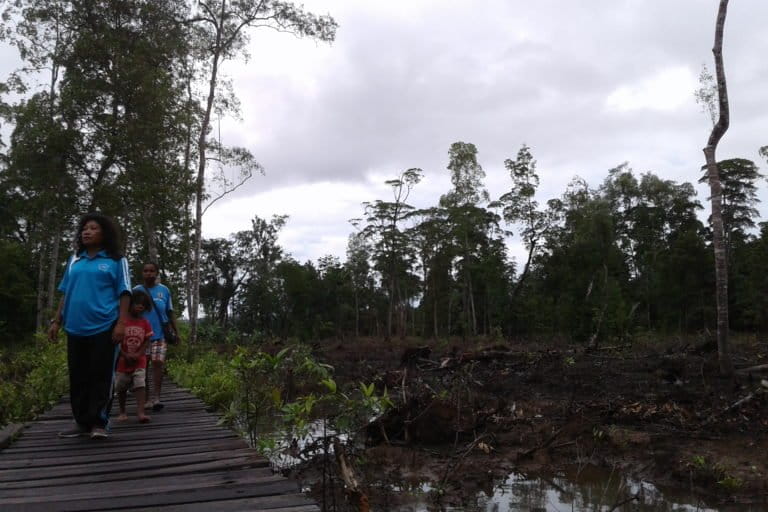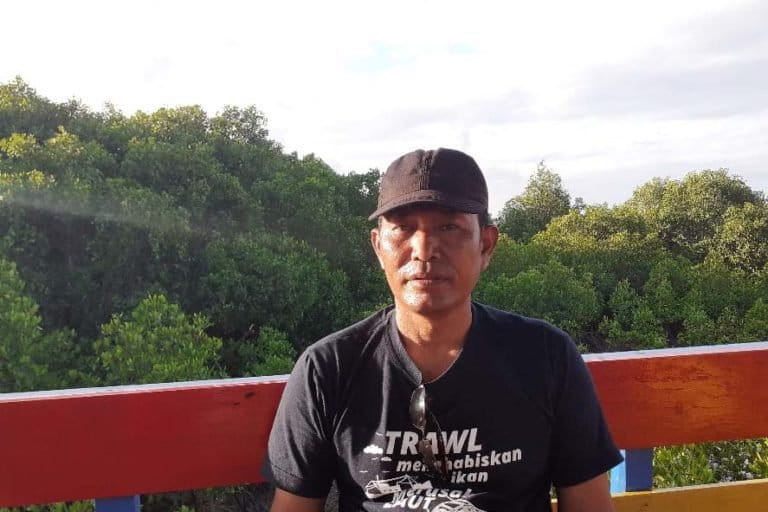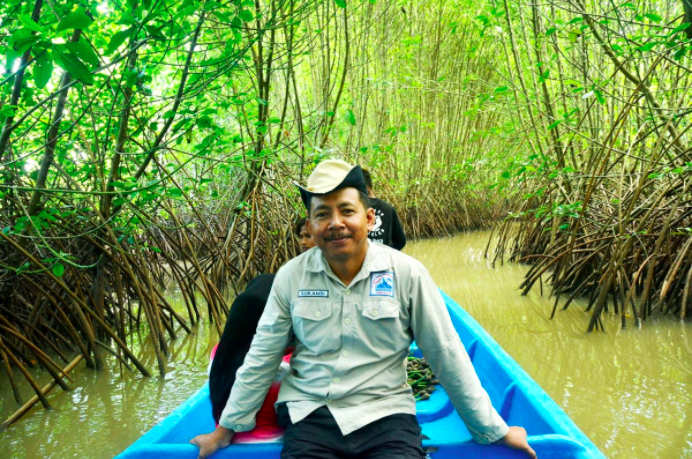- Indonesia is home to 3.2 million hectares (7.9 million acres) of mangroves, more than any other country.
- These coastal forests, which serve as nurseries for countless fish species and help mitigate tidal flooding and tsunami waves, are being cleared for fish farms, charcoal production, and other commercial activities.
- The Indonesian government in 2020 announced a plan to replant 600,000 hectares (1.5 million acres) of mangroves on degraded coastline by 2024.
- But an unsung army of ordinary Indonesians has been toiling around the country for decades to save and grow mangrove forests. These are some of their stories.
Indonesia has more mangrove forests than anywhere else on Earth. The country’s 17,500 islands house around 3.2 million hectares (7.9 million acres) of mangrove, or one-fifth of the world’s remaining area. However, these unique ecosystems crucial for marine habitat, flood control and carbon sequestration are quickly being cleared.
Last year, President Joko Widodo’s administration announced an ambitious plan to replant mangroves on 600,000 hectares (1.5 million acres) of degraded coastline by 2024. While this made headlines, there is some skepticism whether the slow-moving bureaucracy can meet this goal — at least not without the help of local advocates passionate about protecting these vital habitats.
Here we highlight 10 of Indonesia’s mangrove heroes — just a few of the many individuals and local groups who have toiled in relative obscurity while planting hundreds of thousands of trees across the country. They have worked tirelessly for decades, often at great personal expense, to restore these habitats, because they recognize the benefits healthy mangroves provide for their communities.
1) Iwan Winarto: Protecting ecotourism by protecting mangroves

When Iwan Winarto first arrived in the coastal village of Pengudang, on Bintan Island off the eastern coast of Sumatra, he knew the area’s white-sand beaches, stately boulders and clear waters had high potential for tourism. He also learned how its mangroves play a vital role in keeping the water clear despite the bustle of international shipping through the Malacca Strait, and how the seagrass beds provide a home for sea animals such as the endangered dugong (Dugong dugon), a cousin of the manatee.
Recognizing both the environmental and ecotourism value of the village’s 22 hectares (54 acres) of mangrove, Iwan has made it his mission to protect the land and sea through leadership, education and action. From organizing beach cleanups and planting mangrove seedlings to teaching English to the children of local fishermen so that they can run mangrove tours, Iwan works to preserve what he sees as his village’s most valuable asset.
Read the story in Indonesian here.
2) Aziil Anwar: A three-decade labor of love

For nearly half of his 62 years, Anziil Anwar has been working tirelessly to plant and protect mangroves in West Sulawesi province — a passion he developed after he was effectively exiled to the remote village of Majene for refusing to participate in a corrupt scheme by the local forestry department in 1989. Rather than languish as many a shuffled civil servant has, Aziil used his free time (and government salary) to start planting mangroves on coral previously killed by bomb fishing.
Between education programs and tourism activities, Anzill and the Mangrove Learning Center he founded have planted some 60 hectares (148 acres) of forest which are now home to migrating birds and a diversity of fish. He has received several awards for his efforts over the years, and is passing the torch along to his first-born son named, perhaps presciently, Firhan Rimbawan. Rimbawan means “forester” in Indonesian.
Read the story in Indonesian here.
3) Rika Rumadas: Responding to a natural disaster

In 2002, Rika was out on a boat when a 7.6-magnitude earthquake struck the area near Wamesa village in Manokwari, West Papua, sending tsunami waves a meter high (3 feet) that leveled 1,000 houses and killed six people. However, it wasn’t until 2013 that Rika and group of seven women — all over the age of 50, including one 75-year-old — learned that the mangroves they had been cutting for firewood might be their only protection against tsunamis in this earthquake-prone area.
Somewhat embarrassed by their previous transgressions, the women began working three days a week between taking care of house and home, raising and planting 32,000 seedlings on 6 hectares (15 acres) over the next two and a half years. Unfortunately, the transmigrant women did not own the land on which they lived and planted, and much of their forest was destroyed for a government development plan.
Read the story in Indonesian here.
4) M. Taiyeb: Lessons in how to grow a forest

At the age of 84, M. Taiyeb still checks on the fruit of his labor: the Tongke-tongke mangrove forest in South Sulawesi province. Confronted by homes being destroyed by erosion and tidal floods disrupting his village’s aquaculture ponds, Taiyeb began searching for a solution, which he found in a neighboring town where a natural mangrove forest provided a buffer against the sea. He began planting a protective barrier of trees in 1985. The forest now covers more than 786 hectares (1,942 acres).
Through trial and error, Taiyeb discovered that the optimal strategy of planting is spacing the seedlings 50 centimeters (20 inches) apart — much closer than the government-recommended 100 cm (40 in) spacing. By keeping them together, the fragile seedlings are better able to protect each other from incoming waves.
Read the story in Indonesian here.
5) Saptoyo: Reclaiming a cherished childhood memory

In 1998, the mangrove forests around Clungup Beach, on the south coast of Java, were converted into agricultural land, a common scenario around Indonesia. But Clungup was where Saptoyo played as a child, and when the drinking water in his village became cloudy and scarce, he decided it was time to reclaim Clungup Beach for the mangroves. Saptoyo formed an NGO and began developing restoration projects and ecotourism programs to protect several endangered beaches in the area rich with coral and ripe for overexploitation.
More than 108 villagers now participate in Saptoyo’s Clungup Mangrove Conservation Tiga Warna group. They have strict rules on how people can visit their mangrove and coral beaches. Parking areas are located a half kilometer (550 yards) or more away, and the guides inspect guests’ bags to inventory potential trash and ensure it all is carried back out. Through careful management and community support, Clungup Beach is returning to the place that Saptoyo fondly remembers.
Read the story in Indonesian here.
6) Ridwan: Keeping culture alive through nature

Of the 54 km (34 miles) of coastline in Cirebon district, West Java province, only 4.5 km (2.8 mi) are still planted with mangroves. Of that amount, 2 km (1.2 mi) are found in the Ambulu village area. For Ridwan, the story of the disappearing mangroves is emblematic of the story of the people who live in Ambulu — a people also threatened by encroaching industrialization.
Ridwan started a mangrove school to educate his fellow villagers on the importance of these narrow strips of vegetation for holding back the erosion and pollution that threatens their waters. His other organization, Saung Literasi, is committed to ensuring that the culture of his people is not sublimated and forgotten. For Ridwan, “the loss of culture begins with the loss of living landscape,” and both are too important to let be destroyed.
Read the story in Indonesian here.
7) Tazruddin Hasibuan: Fending off destructive industries

While the mangrove forests around Lubuk Kertang village in North Sumatra have long been the victim of exploitation, it was the 1990s permit for a company to burn 20,100 hectares (49,668 acres) to make charcoal that really got Tazruddin “Sangkot” Hasibuan’s attention. In 2006, after much of the area’s mangroves had been destroyed, the permit was revoked. But in the wake of the project, a massive shrimp-farming business and a series of oil palm plantations continued the destruction. While the locals battled to regain rights to the area, their wells filled with saltwater and their houses experienced new flooding previously unheard of in the area.
In 2010, Sangkot took the initiative to rally community leaders and youth groups in the area to start restoring the mangroves around their villages. By 2014, 700 hectares (1,729 acres) had been restored, 410 hectares (1,013 acres) of which Sangkot has managed to get set aside as a community-managed forest, possibly ensuring its lasting protection.
Read the story in Indonesian here.
8) Slaman: From one family to the community

Slaman began helping his father care for the mangroves in Lembung village, on the island of Madura, in 1986 when he was in ninth grade: raising seedlings and planting them after school before doing his homework. They both recognized that flooding and erosion would eventually destroy their village if they didn’t do something. When his father died in 1999, Slaman sought additional help, starting a women’s organization to assist with the endeavor.
Now, in addition to caring for the forest, the group has been developing sustainable mangrove products to sell, including award-winning mangrove coffee, syrup, ice cream, crackers, and natural dyes. In 2019, Slaman began working to get their now 1,174-hectare (2,901-acre) mangrove forest listed as an ecotourism destination.
Read the story in Indonesian here.
9) Sukamsi: Giving street kids a second chance

For much of his life, Sukamsi has been advocating for and helping children who have been living on the streets. He started a halfway house near Ayah Beach on the southern coast of Central Java to help give them opportunities for food, shelter and education. However, when a tsunami wiped out the beach’s fisheries in 2007, it became difficult for the kids to harvest the crabs and fish that supplemented their diet. So Sukamsi and his wards shifted their attention to replanting mangroves to create a safe crab habitat. Locals initially ridiculed the children and Sukamsi, but began changing their tune after the mangroves matured, flooding decreased, and the fisheries returned.
Read the story in Indonesian here.
10) Vinsensius Litan Witi: Going against the grain

In 1995, Vinsensius Litan Witi planted 50,000 mangrove trees along the rocky beaches between the villages of Nobo and Konga on the island of Flores. Most of them died. Undeterred, Vinsensius planted another 25,000 in 1998, and some of those fared better. Encouraged, he and his wife try to plant at least 300 trees each year in their spare time. Some of his neighbors are not happy with the two small forests now growing near town, saying they interfere with their boats and are inviting crocodiles. Vinsensius’s work is plagued by vandalism as some locals uproot the trees under the cover of night.
Recognizing the positive impacts these small groves have created, a group responsible for monitoring for illegal bomb and cyanide fishing have also begun keeping an eye on Vinsensius’s mangroves. On Earth Day this year, Vinsensius’s endeavor gained some of the recognition it deserves when several groups including the East Flores Fisheries Department held a beach cleanup and mangrove-planting event in Nobo.
Read the story in Indonesian here.
FEEDBACK: Use this form to send a message to the author of this post. If you want to post a public comment, you can do that at the bottom of the page.
Banner: Ridwan in the mangroves of Cirebon. Image by Donny Iqbal for Mongabay.
